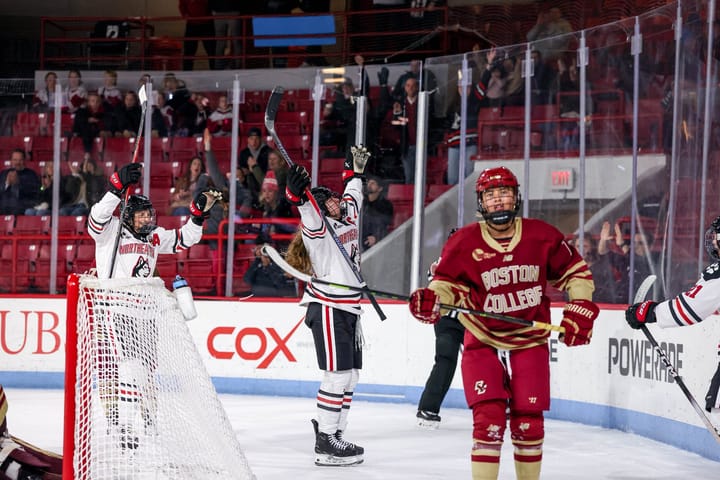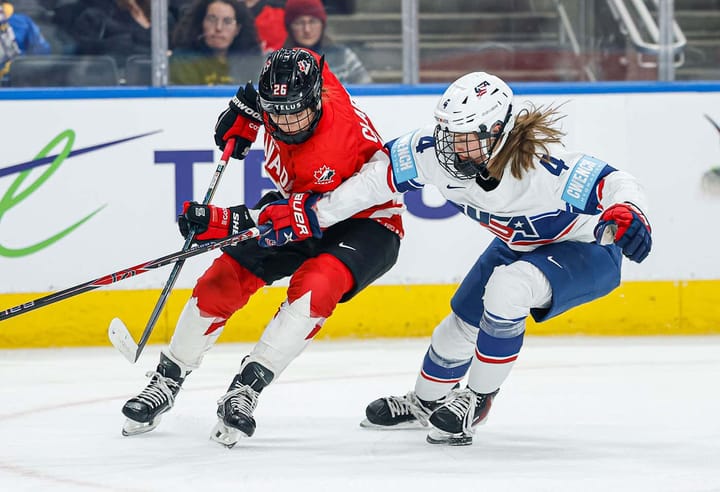NCAA Year in Review: Robert Morris and Syracuse
A review of the CHA’s regular season champions and postseason champions
As the NCAA women’s hockey season winds down, writers Gabriella Fundaro and William Whyte are taking an in-depth look at how each team has shaped up in 2018-19. In the latest round, we’re looking at Robert Morris and Syracuse, who each took home a College Hockey America championship this season.
Related
Robert Morris
William: Last year Robert Morris looked like one of the most dangerous teams in the country. They were fourth in goals for per game played, fifth in goal margin per game played. They had seven players on over 20 points for the season. This year they were down to fifteenth in goals for per game, and against a fairly similar level of opposition (the CHA as a whole was better, but CHA goaltending was worse). Last year they had some huge scores, including a 12-1 blowout of RIT; this year they never scored more than five goals in a game. Although they graduated some elite talent in Brittany Howard, they didn’t lose any other significant contributors and this year, Jaycee Gebhard actually outscored Howard’s points from last year, in a year where Robert Morris’s total points fell from 321 to 248.
What’s your take on the Colonials’ struggles this season? Was it a simply a failure of the parts to add up to something bigger, or was the opposition stronger this year? Should we expect them to bounce back next year? And isn’t “Colonial” an adjective? Shouldn’t it be “Colonists”?
Gabriella: A wise observation, but I’m not inclined to hold it against them considering other teams are guilty of using adjectives as well; while “Colonial” isn’t as colorful as some, it’s way more original. I do think Robert Morris seemed a little thin at times on the offensive side of the puck, which hurt them during crunch time, but for the majority of the year, their goaltending wasn’t quite up to snuff. As a team, they let in 85 goals on 870 shots, for a save percentage of .902. Freshman Arielle DeSmet played four of the final five games of the season, and finished with a .920 save percentage in 10 appearances, so there’s reason to believe goaltending will improve next year.
I’ve enjoyed watching the Colonials over the last couple of seasons, though, and I think they’ve quietly had one of the strongest defensive units around, particularly this season. Maggie LaGue and Kirsten Welsh are both well-established, two-way defenders, and sophomore Emily Curlett had a great season with 11 goals, 21 points, and 148 blocks. Next season, they return both of their leading scorers (Gebhard and Lexi Templeman), but lose some key secondary scoring, as well as both LaGue and Welsh on the blue line. I think they’ll be in the running for a bye in the CHA playoffs, but I’m not sure I see them winning the league again.
Stick taps: The Colonials organized their third annual Teddy Bear Toss, which benefited the Autism Society of Pittsburgh. I wrote a little bit more about that effort earlier this season for At Even Strength.
Losing an edge: Bowing out in the CHA championship game for the second year in a row was a tough way to close the book, especially since Robert Morris was capable of winning it all.
A special team, a historic season. 🍊
— Syracuse Ice Hockey (@CuseIce) March 17, 2019
Won't ever forget about this group. pic.twitter.com/skcAC3btQA
Syracuse
Gabriella: While expectations weren’t super high, this ended up being quite the season for the Orange. They had several major losses to overcome from last year, mainly two of their top-five scorers, Alysha Burriss and Stephanie Grossi. Syracuse held onto third place in the CHA standings, but inconsistent goaltending plagued them, and it didn’t look like they’d solved some of those questions up front, either. Their leading scorer on the season was defender Allie Munroe. None of that seemed to matter when the CHA Tournament rolled around; the Orange made quick work of Lindenwood in game one, finished off Mercyhurst in an exciting back-and-forth semifinal, and then rolled past No. 1 seed Robert Morris for the championship. It felt like the CHA as a whole was wide open this year and the Orange took full advantage to win their first CHA title.
What are your thoughts on the Orange’s season? Did anything stick out to you over the year that signaled they’d make a run for the title?
William: Syracuse are like the opposite of North Dakota: they have a women’s hockey team but no men’s hockey team, they’re orange (which, in Northern Ireland at least, is the opposite of green), and you can safely assume they’ll get beaten by Wisconsin.
In the spirit of opposites, let me first answer the opposite question to the one you asked: what was going wrong for Syracuse this season? I think here the answer is pretty clear: it was the goaltending. I don’t mean to dump on goalies -- my daughter is one, and it’s a hard position -- but Syracuse’s goaltending was the clear worst of all the D1 programs in the nation. The team save percentage was .871; the next worst, Holy Cross, was .887. That save percentage was slightly deflated by the fact that Empty Net let in six goals in its thirteen minutes of playing time -- Empty Net really was the weak link in the Syracuse defense. However, even leaving out empty net goals, the save percentage was .877, still the worst in the country. If you bump their save percentage up to the national average of .914, that’s an extra goal saved every 25 shots, which is literally a goal a game. If you give them that goal a game, and take into account empty net goals that they wouldn’t have given up, their season looks very different. They go from 13-22-3 to 18-15-5, an over .5 win percentage. They have a win over Clarkson, and their 0-1-1 series against Princeton goes to 1-0-1. Their season record against Mercyhurst goes to 4-0-1. They tie Colgate.
Obviously, if you just improve the goaltending, that doesn’t mean the rest of this automatically happens. But maybe Syracuse were a lot closer to being good all along than we realized, and maybe that title run should have been less of a surprise than it was.
Stick taps: Syracuse played in its first ever NCAA Tournament game, taking on No. 1 seed Wisconsin in Madison. They put up a good fight, too, but their season eventually ended in a 4-0 defeat. Earlier in the season, they took Clarkson to overtime in a nailbiter but lost a game where one lucky bounce could have significantly changed the perceptions of both teams.
Losing an edge: The Orange endured a really tough stretch from the middle of November to the middle of January where they were winless for 11 games in a row.





Comments ()